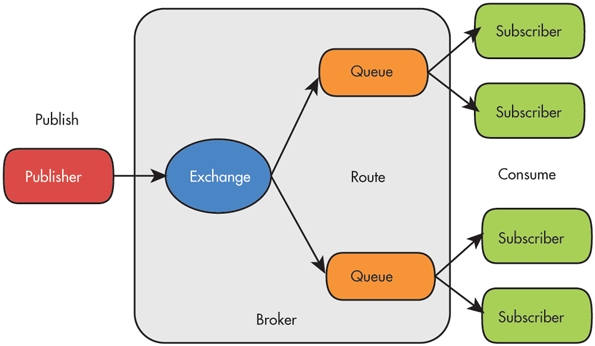简介:
这两天看了消息队列通信,打算在配置平台上应用起来。以前用过 zeromq 但是这东西太快了,还有就是 rabbitmq 有点大,新浪的朋友推荐了 qpid,简单轻便。自己总结了下文档,大家可以瞅瞅。
AMQP(消息队列协议 Advanced Message Queuing Protocol)是一种消息协议 ,等同于 JMS,但是 JMS 只是 java 平台的方案,AMQP 是一个跨语言的协议。
AMQP 不分语言平台,主流的语言都支持,运维这边的 perl,python,ruby 更是支持,所以大家就放心用吧。
主流的消息队列通信类型:
点对点:A 发消息给 B。广播:A 发给所有其他人的消息组播:A 发给多个但不是所有其他人的消息。Requester/response:类似访问网页的通信方式,客户端发请求并等待,服务端回复该请求Pub-sub:类似杂志发行,出版杂志的人并不知道谁在看这本杂志,订阅的人并不关心谁在发表这本杂志。出版的人只管将信息发布出去,订阅的人也只在需要的时候收到该信息。Store-and-forward:存储转发模型类似信件投递,写信的人将消息写给某人,但在将信件发出的时候,收信的人并不一定在家等待,也并不知道有消息给他。但这个消息不会丢失,会放在收信者的信箱中。这种模型允许信息的异步交换。其他通信模型。。。
Publisher --->Exchange ---> MessageQueue --->Consumer
整个过程是异步的.Publisher,Consumer 相互不知道对方的存在,Exchange 负责交换/路由,依靠 Routing Key,每个消息者有一个 Routing Key,每个 Binding 将自已感兴趣的 RoutingKey 告诉 Exchange,以便 Exchange 将相关的消息转发给相应的 Queue!
几个概念
几个概念Producer,Routing Key,Exchange,Binding,Queue,Consumer.Producer: 消息的创建者,消息的发送者Routing Key:唯一用来映射消息该进入哪个队列的标识Exchange:负责消息的路由,交换Binding:定义 Queue 和 Exchange 的映射关系Queue:消息队列Consumer:消息的使用者Exchange类型Fan-Out:类似于广播方式,不管 RoutingKeyDirect:根据 RoutingKey,进行关联投寄Topic:类似于 Direct,但是支持多个 Key 关联,以组的方式投寄。 key以.来定义界限。类似于 usea.news,usea.weather.这两个消息是一组的。

图片 28.1 pic
QPID
Qpid 是 Apache 开发的一款面向对象的消息中间件,它是一个 AMQP 的实现,可以和其他符合 AMQP 协议的系统进行通信。Qpid 提供了 C++/Python/Java/C# 等主流编程语言的客户端库,安装使用非常方便。相对于其他的 AMQP 实现,Qpid 社区十分活跃,有望成为标准 AMQP 中间件产品。除了符合 AMQP 基本要求之外,Qpid 提供了很多额外的 HA 特性,非常适于集群环境下的消息通信!
基本功能外提供以下特性:
采用 Corosync(?)来保证集群环境下的 Fault-tolerant(?) 特性
支持 XML 的 Exchange,消息为 XML 时,彩用 Xquery 过滤
支持 plugin
提供安全认证,可对 producer/consumer 提供身份认证
qpidd --port --no-data-dir --auth
port:端口
--no-data-dir:不指定数据目录
--auth:不启用安全身份认证
启动后自动创建一些 Exchange,amp.topic,amp.direct,amp.fanout
tools:
Qpid-config:维护 Queue,Exchange,内部配置Qpid-route:配置 broker Federation(联盟?集群?)Qpid-tool:监控
咱们说完介绍了,这里就赶紧测试下。
服务器端的安装:
yum install qpid-cpp-serveryum install qpid-tools/etc/init.d/qpidd start
发布端的测试代码:

图片 28.2 pic
一些测试代码转自: ibm 的开发社区
#!/usr/bin/env python #xiaorui.cc #转自 ibm 开发社区import optparse, timefrom qpid.messaging import *from qpid.util import URLfrom qpid.log import enable, DEBUG, WARNdef nameval(st): idx = st.find("=") if idx >= 0: name = st[0:idx] value = st[idx+1:] else: name = st value = None return name, valueparser = optparse.OptionParser(usage="usage: %prog [options] ADDRESS [ CONTENT ... ]", description="Send messages to the supplied address.")parser.add_option("-b", "--broker", default="localhost", help="connect to specified BROKER (default %default)")parser.add_option("-r", "--reconnect", action="store_true", help="enable auto reconnect")parser.add_option("-i", "--reconnect-interval", type="float", default=3, help="interval between reconnect attempts")parser.add_option("-l", "--reconnect-limit", type="int", help="maximum number of reconnect attempts")parser.add_option("-c", "--count", type="int", default=1, help="stop after count messages have been sent, zero disables (default %default)")parser.add_option("-t", "--timeout", type="float", default=None, help="exit after the specified time")parser.add_option("-I", "--id", help="use the supplied id instead of generating one")parser.add_option("-S", "--subject", help="specify a subject")parser.add_option("-R", "--reply-to", help="specify reply-to address")parser.add_option("-P", "--property", dest="properties", action="append", default=, metavar="NAME=VALUE", help="specify message property")parser.add_option("-M", "--map", dest="entries", action="append", default=, metavar="KEY=VALUE", help="specify map entry for message body")parser.add_option("-v", dest="verbose", action="store_true", help="enable logging")opts, args = parser.parse_argsif opts.verbose: enable("qpid", DEBUG)else: enable("qpid", WARN)if opts.id is None: spout_id = str(uuid4)else: spout_id = opts.idif args: addr = args.pop(0)else: parser.error("address is required")content = Noneif args: text = " ".join(args)else: text = Noneif opts.entries: content = {} if text: content["text"] = text for e in opts.entries: name, val = nameval(e) content[name] = valelse: content = textconn = Connection(opts.broker, reconnect=opts.reconnect, reconnect_interval=opts.reconnect_interval, reconnect_limit=opts.reconnect_limit)try: conn.open ssn = conn.session snd = ssn.sender(addr) count = 0 start = time.time while (opts.count == 0 or count < opts.count) and (opts.timeout is None or time.time - start < opts.timeout): msg = Message(subject=opts.subject, reply_to=opts.reply_to, content=content) msg.properties["spout-id"] = "%s:%s" % (spout_id, count) for p in opts.properties: name, val = nameval(p) msg.properties[name] = val snd.send(msg) count += 1 print msgexcept SendError, e: print eexcept KeyboardInterrupt: passconn.close 客户端的测试代码:

图片 28.3 pic
#!/usr/bin/env python #xiaorui.cc ##转自 ibm 开发社区import optparsefrom qpid.messaging import *from qpid.util import URLfrom qpid.log import enable, DEBUG, WARNparser = optparse.OptionParser(usage="usage: %prog [options] ADDRESS ...", description="Drain messages from the supplied address.")parser.add_option("-b", "--broker", default="localhost", help="connect to specified BROKER (default %default)")parser.add_option("-c", "--count", type="int", help="number of messages to drain")parser.add_option("-f", "--forever", action="store_true", help="ignore timeout and wait forever")parser.add_option("-r", "--reconnect", action="store_true", help="enable auto reconnect")parser.add_option("-i", "--reconnect-interval", type="float", default=3, help="interval between reconnect attempts")parser.add_option("-l", "--reconnect-limit", type="int", help="maximum number of reconnect attempts")parser.add_option("-t", "--timeout", type="float", default=0, help="timeout in seconds to wait before exiting (default %default)")parser.add_option("-p", "--print", dest="format", default="%(M)s", help="format string for printing messages (default %default)")parser.add_option("-v", dest="verbose", action="store_true", help="enable logging")opts, args = parser.parse_argsif opts.verbose: enable("qpid", DEBUG)else: enable("qpid", WARN)if args: addr = args.pop(0)else: parser.error("address is required")if opts.forever: timeout = Noneelse: timeout = opts.timeoutclass Formatter: def __init__(self, message): self.message = message self.environ = {"M": self.message, "P": self.message.properties, "C": self.message.content} def __getitem__(self, st): return eval(st, self.environ)conn = Connection(opts.broker, reconnect=opts.reconnect, reconnect_interval=opts.reconnect_interval, reconnect_limit=opts.reconnect_limit)try: conn.open ssn = conn.session rcv = ssn.receiver(addr) count = 0 while not opts.count or count < opts.count: try: msg = rcv.fetch(timeout=timeout) print opts.format % Formatter(msg) count += 1 ssn.acknowledge except Empty: breakexcept ReceiverError, e: print eexcept KeyboardInterrupt: passconn.close Browse 模式的意思是,浏览的意思,一个特殊的需求,我访问了一次,别人也能访问。
Consume 模式的意思是,我浏览了一次后,删除这一条。别人就访问不到啦。
这个是浏览模式:

图片 28.4 pic
sub-pub 通信的例子
Pub-sub 是另一种很有用的通信模型。恐怕它的名字就源于出版发行这种现实中的信息传递方式吧,publisher 就是出版商,subscriber 就是订阅者。
服务端qpid-config add exchange topic news-service./spout news-service/news xiaorui.cc客户端:./drain -t 120 news-service/#.news
PUB 端,创建 TOPIC 点!

图片 28.5 pic
SUB端,也就是接收端!

图片 28.6 pic
总结:
qpid 挺好用的,比 rabbitmq 要轻型,比 zeromq 保险点! 各方面的文档也都很健全,值得一用。话说,这三个消息队列我也都用过,最一开始用的是 redis 的 pubsub 做日志收集和信息通知,后来在做集群相关的项目的时候,我自己搞了一套 zeromq 的分布式任务分发,和 saltstack 很像,当然了远没有万人用的 salt 强大。 rabbitmq 的用法,更是看中他的安全和持久化,当然性能真的不咋地。
关于 qpid 的性能我没有亲自做大量的测试,但是听朋友说,加持久化可以到 7k,不加持久化可以到 1500 左右。
本文出自 “峰云,就她了。” 博客,谢绝转载!
